Let’s find out EXACTLY how many women fake orgasms, why they do it, how to tell if she’s faking it, and a few things they can do to achieve REAL orgasms.
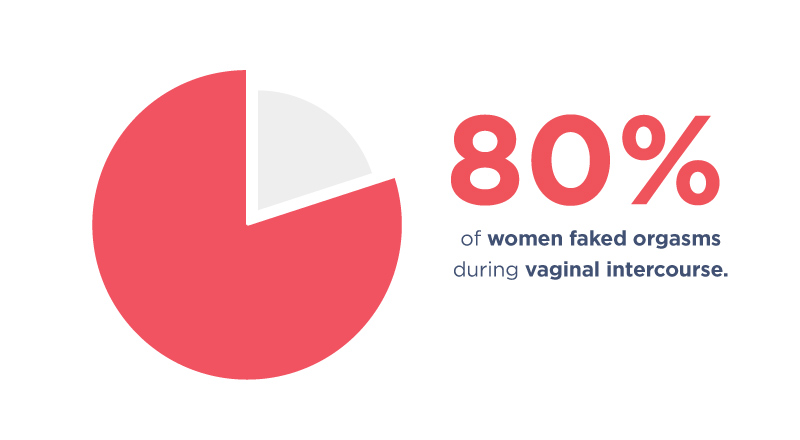
Have you ever “faked it” just to give your partner a bit of an ego boost for the night?
Women faking orgasms is nothing new – in fact, it’s probably been happening since people have been having sex. But recently, there have been many studies that help shed light on exactly how many women fake orgasms – and why they do it.
In this article, we’ve compiled everything you need to know about how many women fake orgasms, how often it happens, the reasoning behind it, and more. Let’s dive in.
Top Fake Orgasm Statistics You Should Know:
- 70% of women experience orgasms exclusively from clitoral stimulation.
- 13-14% of women have never had an orgasm or weren’t sure if they had.
- Women who made more money than their partners were twice as likely to fake orgasms than women who did not make more money than their partners.
- 42.4% of women faked orgasms because they didn’t want to hurt a partner’s feelings.
- A whopping 80% of women faked orgasms during vaginal intercourse.
- Women are 10 times more likely than men to say they only rarely reached their peak.
- FOD (Female Orgasmic Disorder), which results in the lack of orgasms, affects up to 28% of women in the United States and up to 46% in countries across Asia.
Understanding Female Pleasure
Female orgasms continue to be widely studied, and many doctors and scientists believe there is still a lot to learn:
- How women achieve orgasm, and the factors that can prevent them, are still being studied.
- (EverydayHealth, 2018)1
- Biological, psychological, physical, relational, and socio-environmental factors can all have positive or negative effects on orgasms.
- Regardless of how much these factors are controlled for, understanding sexual function isn’t always 100% under our conscious influence.
- (Clue, 2017)2
- Regardless of how much these factors are controlled for, understanding sexual function isn’t always 100% under our conscious influence.
The CUV Complex
The “CUV” Complex (clitoris, urethral sponge, and vagina) is one of the main areas of study for female orgasms. According to these studies, the placement of the clitoris and G-spot has a significant impact on orgasms:
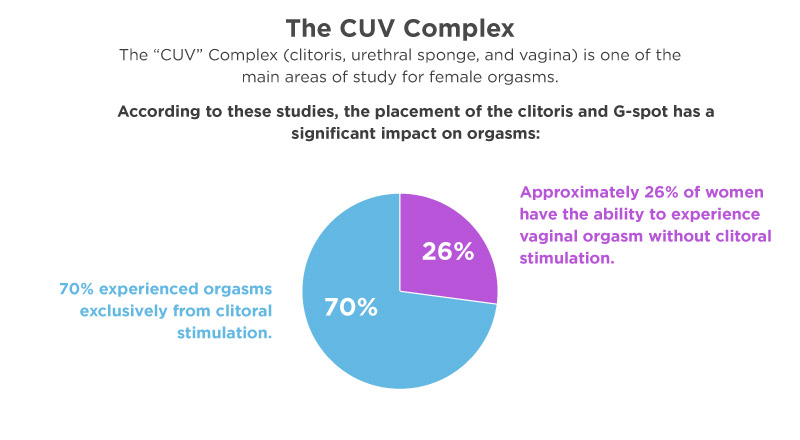
- The CUV Complex is the interconnected structures of the clitoris, urethral sponge, and vagina, which influence each other with pleasure signals through a shared network of nerves.
- Together, the clitoris, urethral sponge (the main part of this is the female prostate), and the vaginal wall all impact arousal.
- (Chloe Macintosh, 2021)3
- Together, the clitoris, urethral sponge (the main part of this is the female prostate), and the vaginal wall all impact arousal.
- Approximately 26% of women have the ability to experience vaginal orgasm without clitoral stimulation.
- 70% experienced orgasms exclusively from clitoral stimulation.
- (Socioaffective Neuroscience & Pathology, 2016)4
- 56% of women reported having a G-spot (a specific portion of the clit that can be stimulated internally).
- The prevalence of reporting this decreased with age.
- (Journal of Sexual Medicine, 2010)5
- 81% of women with lower clitoral placement in the CUV complex have orgasms more than 40% of the time during sex.
- Compared to just 50% of women with high clitoral placement experience orgasms during sex.
- (Hormones and Behavior, 2010)6
Percentage of Women Having Orgasms
If women are faking orgasms – does that mean they don’t have them very often? Here’s what the data says:

- How frequently women experience orgasms:
- 25.2% of women masturbating alone say it takes 2-3 minutes to achieve orgasm.
- 45.7% of these women say it takes a minute or less to achieve a second orgasm.
- (The Journal of Sex Research, 2020)7
- Around 70% of women said they “reach orgasm frequently,” and 10% said they “never did so.”
- In a survey focusing on orgasmic function and sexual behavior related to foreplay and sexual stimulation. (Journal of Sexual Medicine, 2020)8
- 46% of women said they nearly always had an orgasm when having intercourse
- Only 6% of women reported always having an orgasm.
- (Socioaffective Neuroscience & Pathology, 2015.)9
- 64% of women reported having had an orgasm during their most recent sexual encounter, compared to 85% of men.
- (National Survey of Sexual Health and Behavior, 2009)10
- (National Survey of Sexual Health and Behavior, 2009)10
- 25.2% of women masturbating alone say it takes 2-3 minutes to achieve orgasm.
- How many women have never had an orgasm:
- Reaching orgasm during sex:
- Women in a relationship took longer to have an orgasm (13.19 minutes) than women who masturbated (7.16 minutes)
- (The Journal of Sex Research, 2020)8
- Women experienced more frequent orgasms with more attractive partners.
- (Evolutionary Psychology, 2014)12
- Partner attractiveness is the number one factor in factors that predict female sexual satisfaction.
- (Evolutionary Psychology, 2014)12
- (Evolutionary Psychology, 2014)12
- Women in a relationship took longer to have an orgasm (13.19 minutes) than women who masturbated (7.16 minutes)
- Multiple orgasms:
- Most women have the capacity to have multiple orgasms, but research suggests only about 15% actually experience them.
- Women often find their second or third orgasms less intense than their first ones. But this doesn’t mean they are any less pleasurable.
- (International Society for Sexual Medicine, unspecified.)13
- Women often find their second or third orgasms less intense than their first ones. But this doesn’t mean they are any less pleasurable.
- 33.4% of women have an average of 3 orgasms regardless of masturbation or sex.
- (The Journal of Sex Research, 2020)7
- Most women have the capacity to have multiple orgasms, but research suggests only about 15% actually experience them.
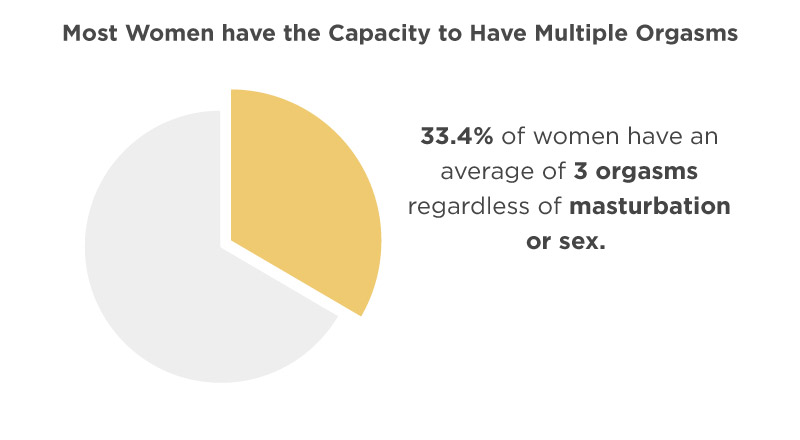
- 12% of women indicate that their highest number of orgasms is 10. (The Journal of Sex Research, 2020)7
So… Why Do Some Women Fake Orgasms?
A lot can help or hinder the ability of women to have an orgasm, and often, it doesn’t come down to someone “doing something
- The main reason women pretend to have orgasms is to manage the difference between expectations and reality.
- “There’s a cultural script at play, where women and their partners expect them to orgasm without external clitoral stimulation. When expectations and reality don’t line up, people fake it.”
- (American Psychological Association, 2011)14
- “There’s a cultural script at play, where women and their partners expect them to orgasm without external clitoral stimulation. When expectations and reality don’t line up, people fake it.”
- Women who made more money than their partners were twice as likely to fake orgasms than women who did not make more money than their partners.
- Participants earned more than their partners 29.6% of the time. On average, women orgasm 64% of the time.
- When not orgasming, they reported faking orgasms 18% of the time.
- (Social Psychological and Personality Science, 2022)15
- (Social Psychological and Personality Science, 2022)15
- When asked why they were faking orgasms:
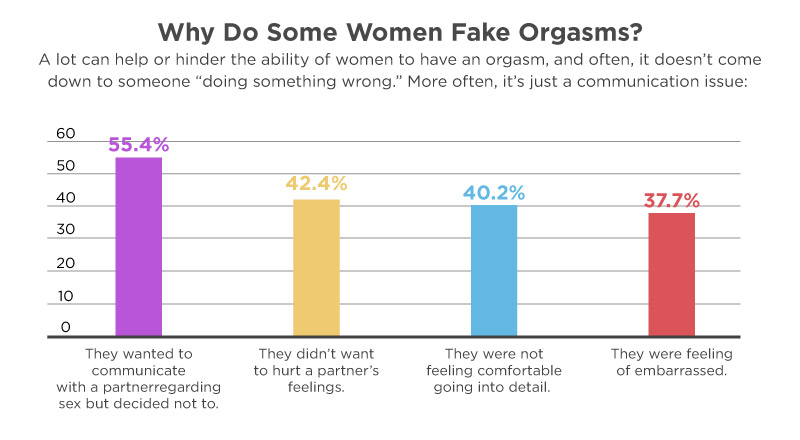
- 55.4% of women reported they wanted to communicate with a partner regarding sex but decided not to.
- 42.4% said they didn’t want to hurt a partner’s feelings
- 40.2% said they were not feeling comfortable going into detail
- 37.7% said they were feeling of embarrassed
- (Archives of Sexual Behavior, 2019)16
- Women also faked orgasms to get their partner to ejaculate quicker because they were experiencing “boredom, fatigue, discomfort, or time limitations.”
- (NBC News, 2010)17
Now you might be wondering – has it always been this way?
Prevalence of Women Faking Orgasms: Throughout the Years
It seems that women have been faking orgasms since the dawn of time… but it may be becoming more common according to this trend in the data:
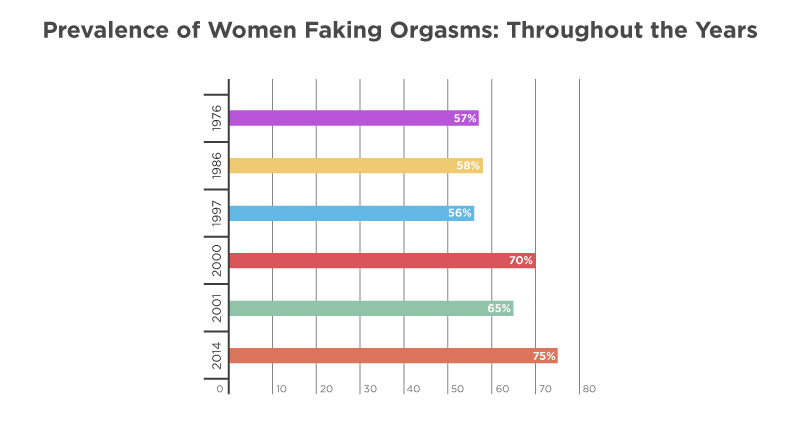
- In 2014: 75% of women had faked an orgasm at least once in their life.
- 45% of these women report that they fake orgasms regularly during sex
- (The University of Maine, 2019)18
- 45% of these women report that they fake orgasms regularly during sex
- In 2001: 65% of participants faked an orgasm at least once during some sort of sexual activity (which may or may not have been intercourse).
- 20% faked orgasms during 20% of their encounters
- The most common way of pretending was physical (i.e., women would move around, contract muscles, bite things, and tense up)
- While many would also fake an orgasm verbally (i.e., women would specifically tell their partner that they had an orgasm)
- (The University of Maine, 2019)19
- In 2000: Of the 2,311 women who answered the questions about faking orgasms, 70% indicated they had faked an orgasm at least once with their partner.
- 75% of these women said that they had faked it less than 50 times
- 10% of the women claimed to have faked orgasm between “150 and 10,000 times… or, in some cases, wrote in another answer such as “countless” or a “bazillion.”
- (The University of Maine, 2019)20
- In 1997: 56% of women studied reported faking an orgasm
- (The University of Maine, 2019)21
- In 1986: 58% had pretended to orgasm of the 745 women who had engaged in sex.
- It was also found that women who pretended to orgasm were more likely to masturbate on their own, were older, had intercourse at a younger age, and had a greater number of sexual partners.
- (The University of Maine, 2019)22
- It was also found that women who pretended to orgasm were more likely to masturbate on their own, were older, had intercourse at a younger age, and had a greater number of sexual partners.
- In 1976: 57% of women reported faking orgasm.
- (Psychology of Women Quarterly, 1976)23
How Often Do Women Fake Orgasms?
Studies have shown that fake orgasms may happen less often than we think – but most women still occasionally fake them:
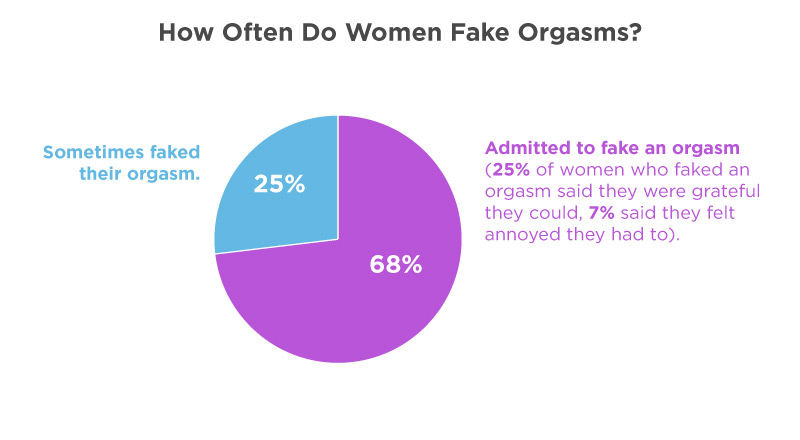
- 68% of women admitted to faking an orgasm compared to 27% of male respondents who said they had faked an orgasm.
- Women were 10 times more likely than men to say they only rarely reached their peak.
- (ZAVA, unspecified)24
- Women were 10 times more likely than men to say they only rarely reached their peak.
- Almost 25% of women said they sometimes faked their orgasm (compared to 5% of men).
- Over 10% either “almost always” or “always” lead their partners to believe they enjoyed sex more than they actually did.
- (ZAVA, unspecified)24
- 25% of women who faked an orgasm said they were grateful they could, but only 7% said they felt annoyed they had to.
- Fewer women also said they felt guilty or ashamed when they just couldn’t reach their climax at the end of a sexual encounter.
- (ZAVA, unspecified)24
- Fewer women also said they felt guilty or ashamed when they just couldn’t reach their climax at the end of a sexual encounter.
- 31% of women who faked an orgasm said their partners decided to try harder after they found out.
- 28% said their partners got annoyed or embarrassed.
- (ZAVA, unspecified)24
- 60% said they would fake an orgasm with the same partner again.
- (ZAVA, unspecified)24
Percentage of Women Who Fake Orgasms
Somewhere between 60-80% of women say they’ve faked an orgasm at some point in their life, studies show:

- 58.8% of female respondents reported having ever faked/pretended to orgasm, and 67.3% of those who had ever faked orgasm no longer did.
- (Archives of Sexual Behavior, 2019)16
- A whopping 80% of women studied said they faked orgasms during vaginal intercourse.
- 25 percent said they fake it 90% of the time.
- (Archives of Sexual Behavior, 2011)25
- Most faking happens during penile-vaginal intercourse:
- Of the women who had ever faked an orgasm, 55 percent pretended in that scenario.
- Only 8% faked it during oral sex and 4% during manual stimulation
- (Kansas University, 2011)26
- 23% of women described faking/pretending they enjoyed themselves throughout the sexual experience.
- Women who had faked an orgasm were more likely to have experienced at least 6 of the following 10 sexual activities:
- Someone stimulating their genitals
- Stimulating someone’s genitals
- Receiving oral sex
- Performing oral sex
- Penila-vaginal intercource (PVI)
- PVI and additional clitoral stimulation
- Anal sex
- Orgasming with another person
- Masturbation
- Orgasming through masturbation
- (Kansas University, 2011)26
- Women who had faked an orgasm were more likely to have experienced at least 6 of the following 10 sexual activities:
Reasons Why Women Fake Orgasms
Another major reason for faking orgasms may come from certain deeply ingrained sexist beliefs, according to these studies:
- Women who believed in “anti-feminist values” – that is, those high in hostile sexism were found to be more likely to:
- Fake an orgasm to keep a partner
- This may stem from a phenomenon of faking orgasm as a “mate retention strategy,” whereby men value orgasms. So women in heterosexual relationships may be more likely to fake their orgasms to satisfy their partner.
- Faking an orgasm to satisfy a partner sexually
- If a woman thinks that, in general, men need their partner to orgasm to be sexually satisfied, she is more likely to fake her orgasm.
- Faking for lack of reason not to
- Women with hostile beliefs about their gender (that is, they reject feminism) faked their orgasms more frequently.
- (Archives of Sexual Behavior, 2019)27
- Fake an orgasm to keep a partner
- 20% – or 1 in 5 women – did not feel comfortable and confident discussing their sexual preferences – which may lead to faking more often.
- 1 in 10 didn’t feel their sexual pleasure mattered to a partner.
- (Archives of Sexual Behavior, 2019)16
- 1 in 10 didn’t feel their sexual pleasure mattered to a partner.
- Women in a relationship with domineering men and those supporting sexist notions were likelier to fake orgasms.
- (GoodTherapy, 2016)28
- Another common reason women may fake orgasms is known as Female Orgasmic Disorder (FOD).
- Female Orgasmic Disorder (FOD) is defined as the absence, delay, infrequency, or marked diminishment in the intensity of orgasms in at least 75% of sexual experiences, persisting for at least 6 months.
- FOD affects up to 28% of women in the United States and up to 46% in countries across Asia.
- (Sexual Medicine Reviews, 2021)29
- Female Orgasmic Disorder (FOD) is defined as the absence, delay, infrequency, or marked diminishment in the intensity of orgasms in at least 75% of sexual experiences, persisting for at least 6 months.
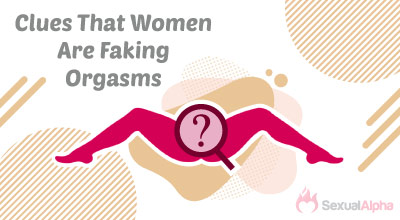
Clues That Women Are Faking Orgasms
If you’ve ever wondered if your partner is faking an orgasm, here are a few potential clues, even though this topic hasn’t been studied in depth.
- Women frequently make conscious vocalizations to influence their partner rather than as a direct expression of arousal.
- (NBC News, 2010)30
- Women are frequently quietest when they are actually receiving pleasure, like during oral sex or foreplay.
- Some make the most erotic noises when sex starts feeling uncomfortable or when they start to get bored.
- (Archives of Sexual Behavior, 2011)25
- Some make the most erotic noises when sex starts feeling uncomfortable or when they start to get bored.
- All women are different, but there is often a “resolution phase” of an orgasm where women are less aware of their surroundings during/after an intense orgasm.
- If she says she came but didn’t look like she was in an altered reality for a minute or two, she may have faked it.
- (GQ, 2017)31
- There are pelvic muscle contractions when a woman has an orgasm. She may have been faking if the vaginal walls don’t pulsate inside.
- (GQ, 2017)31
Why Shouldn’t Women Fake Orgasms
Are there any negative effects to faking an orgasm? Here’s what studies have shown:
- Long-term faking of orgasms can often:
- Lead to resentment between you and your partner because they aren’t helping you orgasm for real.
- Widen the disconnect between you and your partner.
- Keep you from exploring the activities in the bedroom that may actually help you orgasm in the future.
- (Healthline, 2020)32
- You’ll Have a Harder Time Achieving a Real Orgasm:
- “Faking leads to a disconnect with your bodily sensations and perceptions,”
- “And that disconnect can make orgasm more difficult to achieve since you need to focus and be present in order to climax.”
- (Gracie Landes, 2016)33
- You’ll Feel Disconnected From Your Partner:

- People who orgasm are more likely to open up more to their partners during pillow talk afterward.
- Orgasms stimulate the release of oxytocin, AKA the “love hormone,” which helps you bond with your partner.
- (NBC News, 2010)34
- Your Partner Will Feel Like They Can’t Trust You
- If your partner knows you’re faking orgasms, it can lead to a lack of trust in your relationship. Your partner wants to please you, not worry about whether or not you’re pretending.
- (Everyday Health, 2016)35
Treatments/Therapies to Help Women Reach Orgasm
If you or someone you know has never had an orgasm or has a lot of trouble reaching climax: you’re not alone, and it’s not your fault. This is far more common than the media portrays, and several treatments can help.
- As mentioned above, Female Orgasmic Disorder (FOD) is one common reason women fake orgasms. (Sexual Medicine Reviews, 2021)29
- Lifestyle changes and therapy can help:

- Education: Your healthcare provider may want to begin with a discussion of female sexual anatomy and how different parts of the anatomy respond to stimulation. It can help address any questions, clear up misunderstandings and help you understand the purpose of the other recommended treatments.
- Directed masturbation: Directed masturbation programs consist of instruction and at-home exercises that help you become familiar with your own body and explore self-directed sexual stimulation.
- Sensate focus: This approach for couples provides instruction and at-home exercises. It begins with non-erotic touch and gradually introduces more intimate touch and sexual stimulation.
- Changes in sexual positions: Your healthcare provider may recommend changes in sexual positions that increase stimulation of the clitoris during sex.
- Sexual enhancement devices: Some devices enhance sexual stimulation and may assist you in having an orgasm. These include vibrators and air-pulsating devices that stimulate the clitoris.
- Cognitive-behavioral therapy (CBT): Individual or couples therapy may help you address how you think about sex in general or with your partner.
- (MayoClinic, 2022)36
- Medical treatments:

- Estrogen therapy: A low dose of estrogen therapy for the vagina, such as a cream or suppository, can improve blood flow to the genitals and enhance lubrication of the vagina.
- Testosterone therapy: For some postmenopausal women with testosterone levels lower than what is considered typical for women of their age, testosterone replacement may improve arousal and orgasms.
- (MayoClinic, 2022)36
Conclusion
So how many women fake an orgasm occasionally, according to the data? Well…. Most of them. Sorry guys. But at least these studies also show that most women aren’t faking it ALL of the time.
Don’t worry, though: with a bit of practice, determination, and most importantly, communication, you can be one of the outliers 🙂
Footnotes
- EverydayHealth, 2018. “Women and Orgasm: Facts About the Female Climax”
- Clue, 2017. An article on “The science of sexual satisfaction”
- Chloe Macintosh, 2021. Founder of Kama, a sexual wellness educational platform for all bodies
- Socioaffective Neuroscience & Pathology, 2016. A study of “The whole versus the sum of some of the parts: toward resolving the apparent controversy of clitoral versus vaginal orgasms”
- Journal of Sexual Medicine, 2010. A study of 1,804 unselected female twins aged 22-83.
- Hormones and Behavior, 2010. According to a 1940 study from CUMD on 153 normal (109 single, 44 married) and 142 psychotic women (101 single, 41 married)
- The Journal of Sex Research, 2020. A 2020 study of 419 respondents from North America and the Middle East.
- Journal of Sexual Medicine, 2020. A study of 303 US female survey respondents
- Socioaffective Neuroscience & Pathology, 2015. A study of 6155 (only female) Finnish survey respondents.
- National Survey of Sexual Health and Behavior, 2009. An NSSHB study at Indiana University Bloomington
- University of Kansas, 2008. A study of 208 women ages 17 to 48 with ranging ethnicities.
- Evolutionary Psychology, 2014. A study of 54 female undergraduate students of the University of Albany
- ISSM, 2018. An article on What are multiple orgasms? How common are they?
- American Psychological Association, 2011. According to University of Kansas psychology professor Charlene Muehlenhard, PhD
- Social Psychological and Personality Science, 2022. A study of 157 women who were in sexual relationships with men about their sex lives
- Archives of Sexual Behavior, 2019. A study on 1,008 adult women ages 18–94 from the GfK KnowledgePanel
- NBC News, 2010. An article on “Sorry, guys: Up to 80 percent of women admit faking it”
- The University of Maine, 2019. A study of 20 women involving in-depth interviews ages 18-59, and they were recruited in a large metropolitan Southwestern U.S. city.
- The University of Maine, 2019. According to a 2001 study of 366 sexually experienced college from the University of Kansas and were ages 18-26
- The University of Maine, 2019. According to a 2000 study of 2,311 women ages 23 to 95.
- The University of Maine, 2019. According to a 1997 study of 161 college women ages 18-27 from a Midwestern state university.
- The University of Maine, 2019. According to a 1986 study of 868 nurses from around the United States who had completed at least an Associate’s degree in Nursing.
- Psychology of Women Quarterly, 1976. A study of 3,019 women, ages 14 to 78 from Shere Hite’s book “The Hite report: A nationwide study of female sexuality”
- ZAVA, unspecified. A survey of over 2,000 men and women across Europe and the US.
- Archives of Sexual Behavior, 2011. A study of 71 sexually active women ages 18 to 48 on “Evidence to suggest that copulatory vocalizations in women are not a reflexive consequence of orgasm”
- Kansas University, 2011. A study of college women ages 18-29 by professor Charlene Muehlenhard, Ph.D. and Sheena Shippee in the Journal of Sex Research (Vol. 47, No. 6).
- Archives of Sexual Behavior, 2019. A study of 462 heterosexual women from the UK
- GoodTherapy, 2016. A study on The Role of Sexism in Women’s Orgasms
- Sexual Medicine Reviews, 2021. A study on Psychological and Behavioral Treatment of Female Orgasmic Disorder
- NBC News, 2010. According to Gayle Brewer of the University of Central Lancashire
- GQ, 2017. An article of 6 Clues That She’s Faking it
- Healthline, 2020. A medically reviewed article by Healthline
- Gracie Landes, 2016. A sex and family therapist in New York City
- NBC News, 2010. According to a 2014 study of Pillow Talk and Cognitive Decision-making Processes: Exploring the Influence of Orgasm and Alcohol on Communication after Sexual Activity
- Everyday Health, 2016. A medically reviewed article about reasons why you should not fake an orgasm.
- MayoClinic, 2022. An article on Anorgasmia in women